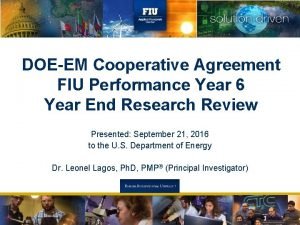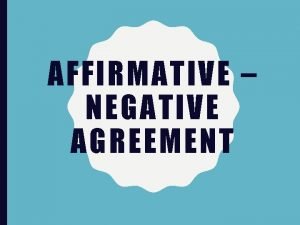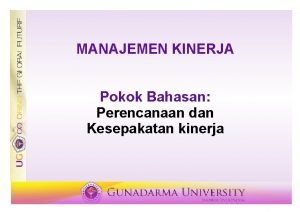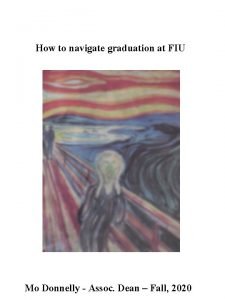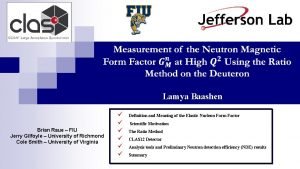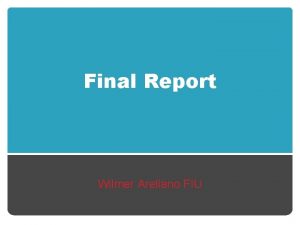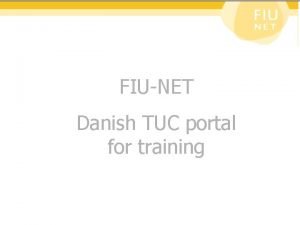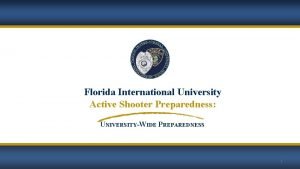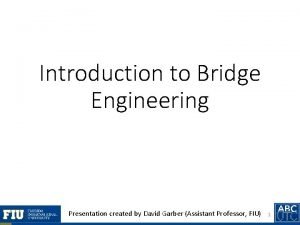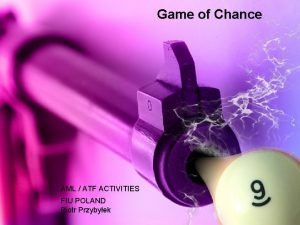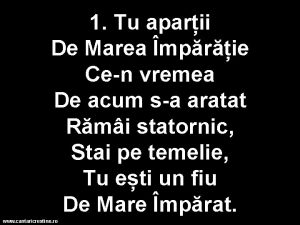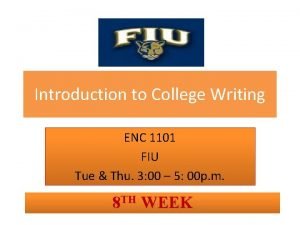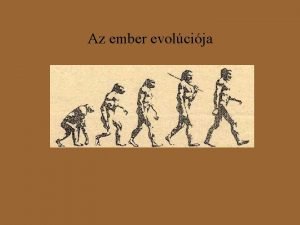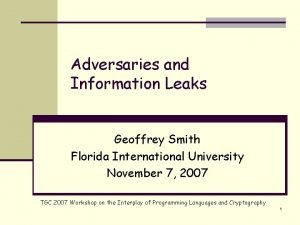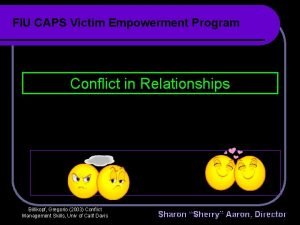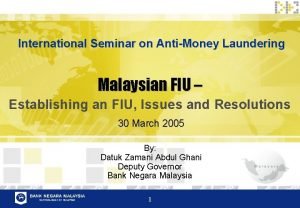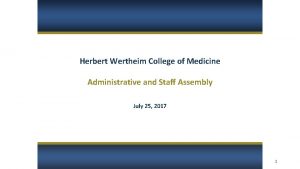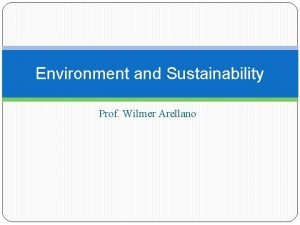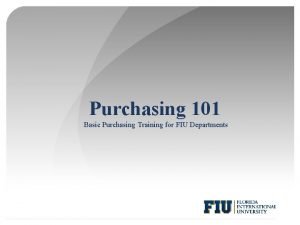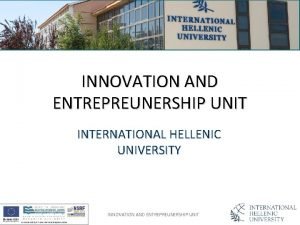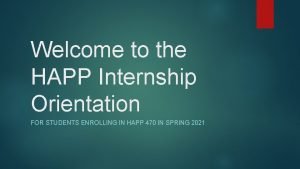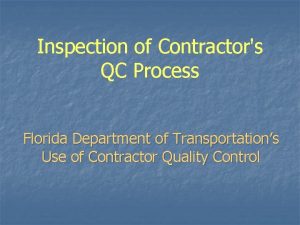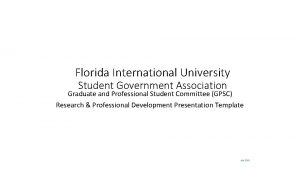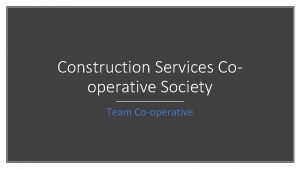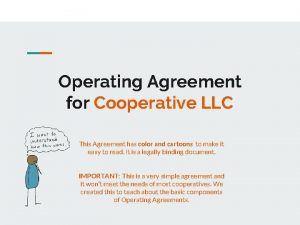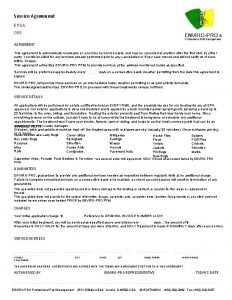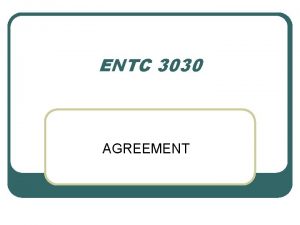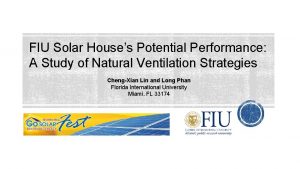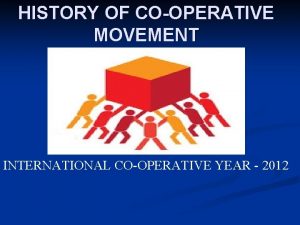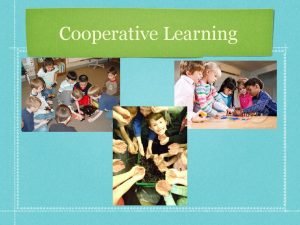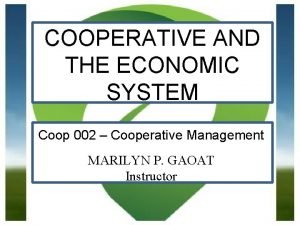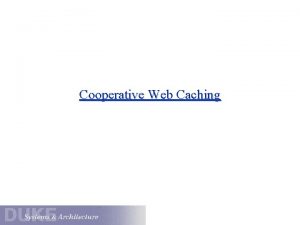DOEEM Cooperative Agreement FIU Performance Year 6 Year
































- Slides: 32

DOE-EM Cooperative Agreement FIU Performance Year 6 Year End Research Review Presented: September 21, 2016 to the U. S. Department of Energy Dr. Leonel Lagos, Ph. D, PMP® (Principal Investigator)

FIU-DOE Year End Research Review Wednesday Sept 21, 2016 Morning 9: 00 - 10: 00 Workforce Development & Training (FIU Project 4) Afternoon 10: 00 - 11: 00 D&D and IT for EM (FIU Project 3) 1: 00 - 2: 00 High Level Waste / Waste Processing (FIU Project 1) 2: 00 - 3: 00 Soil/Groundwater (FIU Project 2) Presentations available at doeresearch. fiu. edu Advancing the research and academic mission of Florida International University.

FIU PROJECT 1 CHEMICAL PROCESS ALTERNATIVES FOR RADIOACTIVE WASTE

FIU Personnel and Collaborators Principal Investigator: Leonel Lagos Project Manager: Dwayne Mc. Daniel Faculty/Staff: Amer Awwad, Dave Roelant, Anthony Abrahao, Aparna Aravelli, Seckin Gokaltun, Hadi Fekrmandi, Reza Abbasi Bahranchi DOE Fellows/Students: Anthony Fernandez, John Conley, Maximiliano Edriei, Gene Yllanes, Michael Di. Bono, Clarice Davila, Erim Gokce, Sebastian Zanlongo, Mackenson Telusma DOE-EM: Gary Peterson, Steve Schneider, Rod Rimando WRPS: Dennis Washenfelder, Terry Sams, Ruben Mendoza, Mike Thien, Jason Gunter NETL: Chris Gunther Advancing the research and academic mission of Florida International University.

Project Description Task 17 Advanced Topics for Mixing Processes • computational fluid dynamics modeling of HLW processes in waste tanks Task 18 Technology Development and Instrumentation Evaluation • • evaluation of FIU’s SLIM for rapid measurement of HLW solids on tank bottoms development of inspection tools for DST primary tanks Task 19 Pipeline Integrity and Analysis • • pipeline corrosion and erosion evaluation nonmetallic materials evaluation Advancing the research and academic mission of Florida International University. 16

Task 17. 1 - CFD Modeling of Mixing Processes in Waste Tanks Background Various mixing processes are required before tank waste can be transferred to facilities for treatment. The processes can involve pulse jet mixers, spargers and potentially other means to generate a homogenous mixture prior to transfer. 14 -ft-diameter vessel to test PJMs Pulse Jet Mixers (PJM) PJMs contain pressurized vessels which intake the waste and discharge it back out at high velocity creating radial jets. These jets collide at the center of the vessel creating an up wash and promoting circulating motions. PJM circulation Demonstration Advancing the research and academic mission of Florida International University.

Task 17. 1 - CFD Modeling of Mixing Processes in Waste Tanks Objective Develop computational capability as a prediction tool to: – Evaluate the performance of mixing mechanisms for high-level waste – support critical issues related to HLW retrieval and processing Present Tasks • Capabilities of Star-CCM+ code will be improved incrementally to obtain a comprehensive tool that includes the complex flow features of HLW mixing • Star-CCM+ will be used in order to investigate accuracy of correlations used to predict impacts of the radial jets on LLW mixing Advancing the research and academic mission of Florida International University.

Task 17. 1 - CFD Modeling of Mixing Processes in Waste Tanks Results • 3 D modeling of non-Newtonian fluids using QDNS and RANS were validated with experimental data. Improved previous efforts to match experimental data. • Investigated shear dependency to improve RANS modeling – QDNS and RANS were found to be significantly different. • Our current modified RANS method also was significantly different from the QDNS shear dependency. Advancing the research and academic mission of Florida International University.

Task 17. 1 - CFD Modeling of Mixing Processes in Waste Tanks Results • • Radial Jet Characteristic Comparison Used Star-CCM+ to validate Poreh’s correlations to determine jet thickness and max velocity for various geometric configurations. Poreh’s formula was fairly accurate for the r/b and b/d ranges of current PJM systems when predicting velocity and jet thickness. Jet Thickness Jet Maximum Velocity Flat Impingement Jet Maximum Velocity Jet Thickness Curved Impingement Advancing the research and academic mission of Florida International University.

Task 17. 1 - CFD Modeling of Mixing Processes in Waste Tanks Tasks for FIU Performance Year 7 Need - accurate prediction of concentration of undissolved solids in waste tank feed delivery system at Hanford using CFD modeling. • To build a CFD model (Star-CCM+) that is capable of accurately predicting metrics for particle mobilization, suspension, settling, transfer line intake, and pipeline transfer. Need –understanding of the operation time needed to fully mix vessels at Hanford. Experimental testing on mixing time of ethanol in the sparging of Bingham plastics was performed at NETL. • To evaluate Star-CCM’ s capability of matching experimental data pertaining to the field of non. Newtonian sparging mixing vessels. • Gain insight into the effects of rheological and physical characteristics on mixing times for accurate prediction in PJM operation. (Experimental setup) Advancing the research and academic mission of Florida International University. (Data obtained from experimental set up)

Task 18. 1 - Evaluation of FIU’s 3 D Sonar for Small Changes in Surface Layer of HLW as an Indicator of DSGREs Motivation Recently, engineers at Hanford have been focusing on increasing tank space in DSTs to mitigate issues related to the aging of SSTs. One of the major concerns associated with these transfers is the potential release of flammable gas. This can occur when the sludge levels are exceedingly high in the DSTs and is referred to as a deep sludge gas release event (DSGRE). Objective Monitor the settled solids layer in double shelled tanks to image any increase in volume of the waste as an indicator of the buildup of gas in the deep sludge layers Challenge Create a continuous monitoring capability using data filtering, processing and 3 D visualization allowing operators to see any increase in height (volume) of the settled solids layer in the tanks Advancing the research and academic mission of Florida International University.

Task 18. 1 - Evaluation of FIU’s 3 D Sonar for Small Changes in Surface Layer of HLW as an Indicator of DSGREs Results • Developed computer code to post process and image scans from a commercial 3 D sonar. • Developed a lab scale testbed and conducted initial tests in water to validate sonar’s ability to detect small variations in surface height. • Accuracy to 6 mm is easily imaged at a sonar to solids distance of 30 cm (1 ft) • Currently developing code to correlate changes in surface height with gas volume. Sand was mounded over an air bladder and placed on the test tank floor. Air was added in 2 stages to the bladder under the sand. Three Sonar Images Left: sand over empty bladder Middle: sand surface after air is added Right: sand surface after 2 nd increment of air is added Advancing the research and academic mission of Florida International University.

Task 18. 1 - Evaluation of FIU’s 3 D Sonar for Small Changes in Surface Layer of HLW as an Indicator of DSGREs Tasks for FIU Performance Year 7 Effort has completed at the end of Performance Year 6. Advancing the research and academic mission of Florida International University.

Task 18. 2 - Development of Inspection Tools for DST Primary Tanks Background • Tank waste was found in the annulus of tank AY-102. • An inspection tool is required to isolate and pinpoint the source of the material entering Tank AY -102 annulus space • There are three possible entry points: (1) refractory air slots through the annulus, (2) 6” leak detection piping, (3) 4” air supply piping Advancing the research and academic mission of Florida International University.

Task 18. 2 - Development of Inspection Tools for DST Primary Tanks Mini Rover Objective (Kayle Boomer, WRPS 2015) To develop an inspection tool that navigates through the refractory pad air channels under the primary liners of the DST’s at Hanford while providing live video feedback Design parameters Travel through small cooling channels AY Tank Farm Remote controlled Provide live video feedback AZ/SY/AW/AN/AP Tank Farm Rad hardened (~ 80 rad/hr) Withstand relatively high temperatures (~ 170 °F) Navigate ~ 50 feet to the tank center Maneuver through four 90° turns Subject the channel to pressures not greater than 200 psi (Brandon J. Vazquez, WRPS 2015) Advancing the research and academic mission of Florida International University. (Jason Gunter, WRPS 2015)

Task 18. 2 - Development of Inspection Tools for DST Primary Tanks Mini Rover Results /Accomplishments Improved design: • Stronger body • Lighter tether • Better controls Bench scale test Cable management Advancing the research and academic mission of Florida International University.

Task 18. 2 - Development of Inspection Tools for DST Primary Tanks Peristaltic Crawler Objective To develop an inspection tool that crawls through the air supply pipe that leads to the central plenum of the primary tank of the DSTs at Hanford and provides video feedback Design parameters • Remotely controlled • Video feedback recorded for future analysis • Radiation hardened (~ 80 rad/hr) • Exposure to elevated temperatures (~ 170 F) • Maneuver in pipes and fittings with 3” and 4” diameter • Navigate through elbows, bends, transitions and vertical runs Proposed inspection -approximately 100 feet (significant portion is gravity fed) Advancing the research and academic mission of Florida International University.

Task 18. 2 - Development of Inspection Tools for DST Primary Tanks Peristaltic Crawler Results/Accomplishments Instrumentation: • Embedded computer • Tether load cell • Additional sensors Bench scale test Portable control box Advancing the research and academic mission of Florida International University.

Task 18. 2 - Development of Inspection Tools for DST Primary Tanks Objective Sectional Mock-up of DSTs To design a full scale mockup of the DST to evaluate inspection technologies and robotic devices Design parameters Modular design Dimensions 36’ length x 5’ width x 17’ height Simulate several inspection conditions: • • Refractory pad Wall thickness Center plenum access Cooling channels geometry Defects Damaged weld beds, and bottom cracks. Advancing the research and academic mission of Florida International University.

Task 18. 2 - Development of Inspection Tools for DST Primary Tanks Tasks for FIU Performance Year 7 Crawler • Assemble full-scale mock up test bed • Validate system in mock up • Investigate sensor integration - temperature, radiation, UT • Scale design for inspection in 6 inch leak detection line Rover • Complete design and development of the cable management system • Investigate and develop delivery mechanism for easy deployment • Investigate sensor integration - temperature, radiation, UT • Validate system in mock with various refractory pad configurations Advancing the research and academic mission of Florida International University.

Task 18. 3 - Investigation Using an Infrared Temperature Sensor to Determine the Inside Wall Temperature of DSTs Background Operating Specifications for the DSTs (OSD-T-151 -00007) specifies the temperature requirements for waste • Current temperature methods – process knowledge, approximations, measuring devices and modeling – at least 10 feet from the wall due to equipment and technical constraints • Models estimate wall conditions • Typically not validated with field data Objective Demonstrate the use of an IR sensor to approximate the inside wall temperature of DSTs – Utilize bench scale tests and heat transfer calculations Advancing the research and academic mission of Florida International University.

Task 18. 3 - Investigation Using an Infrared Temperature Sensor to Determine the Inside Wall Temperature of DSTs Results/Accomplishments • Developed test plan to evaluate IR sensor – Vary plate thickness, water temperature, sensor elevation, distance of sensor to tank wall • Procured IR Sensor (Raytek MI 3) – Initial system configuration • Conducted emissivity tests – material calibration (carbon steel) • Completed bench scale testing – construction of the bench scale test bed and executing the test plan Advancing the research and academic mission of Florida International University.

Task 18. 3 - Investigation Using an Infrared Temperature Sensor to Determine the Inside Wall Temperature of DSTs Results/Accomplishments • Modeling and simulation – Developed model to estimate internal wall temperature simulation of heat transfer in the DST’s Fundamental Heat Transfer Theory • X - horizontal distance in the annulus (ft. ); Y- vertical height (ft. ); T -temperature of water (0 F) Advancing the research and academic mission of Florida International University.

Task 18. 3 - Investigation Using an Infrared Temperature Sensor to Determine the Inside Wall Temperature of DSTs Tasks for FIU Performance Year 7 • Improve current testbed with multiple thermocouples and a data acquisition system • Test the IR sensor with new system on testbed with different design parameters. Validate using simulation models • Test the IR sensor on sectional mock up testbed of DSTs tank • Investigate the integration of the IR sensor into a robotic platform Advancing the research and academic mission of Florida International University.

Task 19. 1 – Pipeline Corrosion and Erosion Evaluation Background Due to uncertainties regarding the structural integrity of pipelines at Hanford, a Fitness-for -Service (FFS) program for the Waste Transfer System has been implemented. A direct inspection and assessment of the condition of buried pipelines is required to evaluate the corrosion and erosion wear rates. To predict the existing system’s remaining useful life UT sensors Objective Investigate the use of remote permanently mounted Ultrasonic Transducer (UT) systems for measuring pipe wall thickness Advancing the research and academic mission of Florida International University.

Task 19. 1 - Pipeline Corrosion and Erosion Evaluation Results/Accomplishments • Evaluated various couplants (gel and dry) for UT sensing using an Olympus dual element sensor – Dry couplants provided inconsistent results – Vacuum testing was conducted to evaluate removal of air gaps • Conducted a review of alternative sensor systems that meet the site requirements Ultran WD 25 -2 UT sensors – dry couplant, small sizes, accuracy of 0. 001 in, semi permanent mounting, rad environment • Down selected sensors to two – Permasense guided wave sensors – limited to 2 sensors for 2 in diameter pipes – Ultran Group – couplant free sensors Permasense – guided wave sensors Advancing the research and academic mission of Florida International University.

Task 19. 1 - Pipeline Corrosion and Erosion Evaluation Tasks for FIU Performance Year 7 • Assess the accuracy of the Permasence sensors on pipe sections and fittings (2, 3 and 4 inch diameters systems). • Develop experimental test loop to validate the use of the sensors. Determine optimal simulants to age/errode the pipe loop. • Evaluate the sensors on the DST sectional mock-up. • Investigate the potential integration of the sensors into robotic devices. Advancing the research and academic mission of Florida International University.

Task 19. 2 - Evaluation of Nonmetallic Components in the Waste Transfer System Background: • • Nonmetallic materials are used in the US DOE’s Hanford Site Tank Farm waste transfer system. These include inner primary hoses in the HIHTLs, Garlock® gaskets, EPDM O-rings, and other nonmetallic materials. Nonmetallic materials are exposed to β and γ irradiation, caustic solutions as well as high temperatures and pressure stressors. How they react to each of these stressors individually has been well established, but simultaneous exposure of these stressors is of great concern. Objective: • • Provide the Hanford Site with data obtained from experimental testing of the hose-in-hose transfer lines, Garlock® gaskets, EPDM O-rings, and other nonmetallic components under simultaneous stressor exposures. Due to experimental testing location limitations, no radiation exposure testing will be conducted. Advancing the research and academic mission of Florida International University.

Task 19. 2 - Evaluation of Nonmetallic Components in the Waste Transfer System Phase 1 Test Plan: • • • Phase 1 will be limited to EPDM material testing (HIHTL, O-rings and gaskets). EPDM was selected for this phase of testing due to its use in multiple applications within the Hanford waste transfer system. Material will be simultaneously exposed (aged) to both high temperature (85 o. F, 130 o. F and 180 o. F) and caustic solution stressors. A 25% sodium hydroxide solution will be used as the chemical stressor. Material will be aged while in-service configuration as well as coupons for 180 and 360 days. Post exposure mechanical performance testing will be conducted including burst pressure tests, leak tests (in-service configuration) and stiffness, tensile strength tests (coupons). Advancing the research and academic mission of Florida International University.

Task 19. 2 - Evaluation of Nonmetallic Components in the Waste Transfer System • Due to limitations in resources – 24 coupons were manufactured by Riverbend – – – 6 room temp (180, 360 days) 6 operating temp (180, 360 days) 6 elevated temp (180 360 days) 3 baseline testing 3 additional – elevated temp for 60 days if needed • A test loop was designed and manufactured that will age the HIHTLs, O-rings, gaskets and material coupons. Nonmetallic test loop Advancing the research and academic mission of Florida International University.

Task 19. 2 - Evaluation of Nonmetallic Components in the Waste Transfer System Baseline Results Blowout tests: • 3 hose coupons were tested with an average blowout pressure of 2805 psi In-configuration leak tests: • 3 flanges and 3 O-rings were leak tested in configuration at 150 psi and 255 psi respectively Material tests: • • Tensile tests – peak load, stress, modulus for EPDM and Garlock coupons Hardness tests Advancing the research and academic mission of Florida International University.

Task 19. 2 - Evaluation of Nonmetallic Components in the Waste Transfer System Tasks for FIU Performance Year 7 • Continue to age the non-metallic components for the 6 month and year intervals. • After the 6 months of aging, specimens will be removed and tested to determine the level of degradation in strength and material properties. • Based on results of testing, additional data points may be needed for evaluation or modifications to the current system may need to be incorporated. • Additional stressors may also be considered for testing. – Additional stressors may also be incorporated into the testing. Advancing the research and academic mission of Florida International University.
 Christine wipfli
Christine wipfli Positive negative agreement
Positive negative agreement Agreement performance
Agreement performance Fiu intelligence fellowship
Fiu intelligence fellowship Fiu graduation requirements
Fiu graduation requirements Fiu ipt
Fiu ipt Brian raue fiu
Brian raue fiu Wilmer arellano fiu
Wilmer arellano fiu Danish fiu
Danish fiu Shooting at fiu
Shooting at fiu David garber
David garber Fiu poland
Fiu poland Fiu cew
Fiu cew Cantaricrestine
Cantaricrestine Enc 1101 fiu
Enc 1101 fiu Turkana ember
Turkana ember Professor geoffrey smith fiu
Professor geoffrey smith fiu Fiu caps
Fiu caps Fiu malaysia
Fiu malaysia Winnie chang fiu
Winnie chang fiu Wilmer arellano fiu
Wilmer arellano fiu Fiu procurement
Fiu procurement Fiu camvas
Fiu camvas My.fiu
My.fiu Fiu ipt
Fiu ipt Ocean bank convocation center
Ocean bank convocation center Wilmer arellano fiu
Wilmer arellano fiu Travel and entertainment master card
Travel and entertainment master card Eic fiu
Eic fiu Ctqp fiu
Ctqp fiu Gpsc fiu
Gpsc fiu Wilmer arellano fiu
Wilmer arellano fiu Jcids manual
Jcids manual
